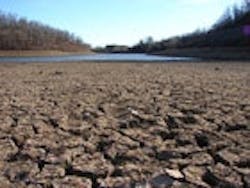California Governor Proclaims State of Emergency in Response to Drought
To combat California’s third consecutive year of drought, Governor Arnold Schwarzenegger proclaimed a state of emergency Feb. 27 and ordered immediate action to manage the crisis. In the proclamation, the Governor uses his authority to direct all state government agencies to utilize their resources, implement a state emergency plan and provide assistance for people, communities and businesses impacted by the drought.
“Even with the recent rainfall, California faces its third consecutive year of drought and we must prepare for the worst—a fourth, fifth or even sixth year of drought,” Schwarzenegger said. “Last year we experienced the driest spring and summer on record and storage in the state’s reservoir system is near historic lows. This drought is having a devastating impact on our people, our communities, our economy and our environment - making today’s action absolutely necessary. This is a crisis, just as severe as an earthquake or raging wildfire, and we must treat it with the same urgency by upgrading California’s water infrastructure to ensure a clean and reliable water supply for our growing state.”
The Governor’s order directs various state departments to engage in activity to provide assistance to people and communities impacted by the drought. The proclamation:
• Requests that all urban water users immediately increase their water conservation activities in an effort to reduce their individual water use by 20%;
• Directs the Department of Water Resources (DWR) to expedite water transfers and related efforts by water users and suppliers;
• Directs DWR to offer technical assistance to agricultural water suppliers and agricultural water users, including information on managing water supplies to minimize economic impacts and implementing efficient water management practices;
• Directs DWR to implement short-term efforts to protect water quality or water supply, such as the installation of temporary barriers in the Delta or temporary water supply connections;
• Directs the Labor and Workforce Development Agency to assist the labor market, including job training and financial assistance;
• Directs DWR to join with other appropriate agencies to launch a statewide water conservation campaign calling for all Californians to immediately decrease their water use; and
• Directs state agencies to immediately implement a water use reduction plan and take immediate water conservation actions and requests that federal and local agencies also implement water use reduction plans for facilities within their control.
In particular, the order directs that by March 30, 2009, DWR shall provide an updated report on the state’s drought conditions and water availability. According to the proclamation, if the emergency conditions have not been sufficiently mitigated, the Governor will consider additional steps. These could include the institution of mandatory water rationing and mandatory reductions in water use; reoperation of major reservoirs in the state to minimize impacts of the drought; additional regulatory relief or permit streamlining as allowed under the Emergency Services Act; and other actions necessary to prevent, remedy or mitigate the effects of the extreme drought conditions.
DWR and California’s Department of Food and Agriculture will also recommend, within 30 days, measures to reduce the economic impacts of the drought, including but not limited to water transfers, through-Delta emergency transfers, water conservation measures, efficient irrigation practices, and improvements to the California Irrigation Management Information System.
Earlier in February, DWR announced that California’s severe drought had prevented it from increasing its State Water Project (SWP) delivery allocations for the first time since 2001. This year’s allocation as of February is at just 15% of SWP contractor’s requests. This is only the second time in SWP history that the February allocation has been this low.
The drought conditions and water restrictions are causing additional devastating economic and business losses. Agricultural revenue losses exceed $300 million to date and could exceed $2 billion in the coming season, with a total economic loss of nearly $3 billion in 2009.
Source: State of California
